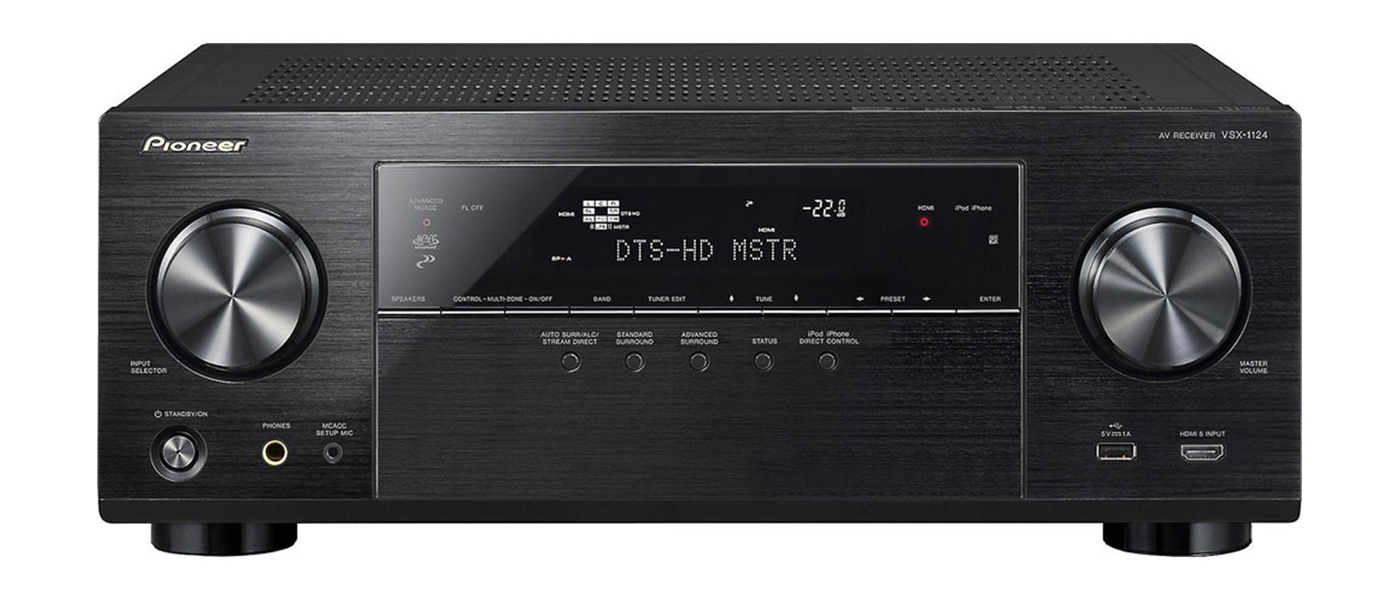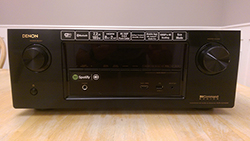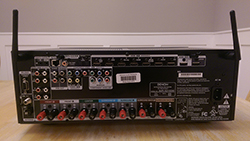Denon AVR-X2100W A/V Receiver Review Highlights
The Denon X2100W IN-Command receiver adds plenty of great network integration features to the usual mix of Denon features and performance to deliver a great value in the mid level receiver market. The X2100W includes network management via web or mobile OS applications to ensure an excellent user experience. The receiver handles 4K video, a large range of audio file formats, and nearly all major audio codecs from Dolby and DTS, making it a perfect central hub of your home theater experience.

Denon AVR-X2100W A/V Receiver Highlights Summary
- Superb User Experience for initial setup and configuration of the receiver
- Network connectivity via built in wired or WiFi adapters
- Integrated Bluetooth audio for easy streaming from any A2DP Bluetooth enabled device
- ECO mode to ensure efficient power usage during both operation and standby
- Management apps for ultimate ease of use and convenience
- Excellent audio and video performance
Introduction to the Denon AVR-X2100W A/V Receiver Review
Denon has a long history of making high quality audio gear. A/V receivers have always been one area where Denon has innovated and been an industry leader in terms of feature set and price/performance. Their new-ish IN-Command series of receivers continue to push these values, with the additional focus on networking and custom integration. The AVR-X2100W is an affordable model in the IN-Command line up that is packed with great features and connectivity options for home theater enthusiasts. On paper, this receiver seems to cover all the bases, so I was excited to put it through its paces. Hey, that rhymes…
DENON AVR-X2100W A/V RECEIVER REVIEW SPECIFICATIONS
- Design: 7.2 A/V Receiver
- Power Amplifier: 7 x 95 Watts into 8 Ohms
- 8 HDMI Inputs Supporting 4K, 4:4:4 Pure Color Pass-through
- Audio Codecs Supported: DTS HD Master, DTS ES, DTS 96/24, Dolby TrueHD, Dolby Digital EX, ProLogic IIz, MP3, WMA, AAC, FLAC, ALAC, WAV
- Dimensions: 6.6″ H x 17.1″ W x 13.4″ D
- Weight: 21.4 Pounds
- MSRP: $749 USD
- Denon
- SECRETS Tags: Denon, Denon AVR X2100W, 2014 Receiver Reviews, 7.2 Channel Amplifier, Network Connectivity
Setup and Configuration of the Denon AVR-X2100W A/V Receiver
The X2100W includes 8 HDMI inputs that are compatible with 3D, 4K/60fps and 4K/30fps formats along with all standard resolutions and audio codecs. There are 2 HDMI monitor outputs, which support audio return channel (ARC) in case you wish to use a Smart TV’s network features yet leverage advanced audio processing through the receiver.
One of the AUX HDMI inputs is located on the front of the unit next to a powered USB port, which would allow a Chromecast or Roku streaming stick, for example, to be plugged in to HDMI as well as power in one space. Also included are 2 composite inputs, 2 component inputs, 2 optical digital inputs, and 1 coaxial digital audio input. This was more than enough to accommodate the major items in my cabinet, including a Blu-Ray player, HD-DVR/satellite receiver, Xbox 360, Apple TV, and even a Nintendo Wii.
Additionally, while the receiver does have Wi-Fi capability, I have an available wired ethernet jack in my cabinet, so I connected it as well. These days you will find that a network connection supports a good portion of the receiver’s functionality, and is almost a necessity – much more on this later. Speaker connections are well laid out and color-coded.
The receiver leverages four-way binding posts, and I elected to simply use bare wire and screw down the speaker terminals. For those that require it, there is also an RS-232 serial port, as well as second zone control. After connecting components and speakers, I was ready to begin the (supposedly) arduous task of configuring and tuning everything.
The progress in terms of usability was apparent immediately. Upon powering up the unit for the first time it had beautiful on screen graphics and text that stepped me through connecting speakers to the speaker terminals and how best to set it up (even though I had already connected everything, I think this is a great feature).
First it asked me if I had a center channel, then surround sound channels, then surround rear channels, and finally a subwoofer. Not only did each screen ask me those questions, but they also showed a picture of where these speakers should be positioned, so it is totally specific as to the difference between surround and surround rears.
In addition, it showed in full detail where on the receiver’s backside to connect each speaker cable and subwoofer LFE coaxial cable. In a very welcome touch, it then plays a test sound through each channel and confirms you have connected them correctly, and unlike the annoying white noise tones of yore, it plays a nice little melody.
Next, it gave a brief summary of what room equalization does, and how Audyssey MultiEQ does it. It directs you to use a tripod, or, for those of us non-photographers, an included cardboard extendable microphone stand with the included Audyssey microphone to begin the setup routine.
I will pause here to say that although the cardboard stand could use a bit better design for the notches to keep the height properly in place, this is one of the best ideas I’ve seen come along for a receiver in a long time. It is such a simple thing to include a cheap cardboard mount, but the convenience factor is fantastic for those of us without a real tripod.
That said, once I got the microphone mounted on the stand, the graphical user interface (GUI) directed me through the now standard setup routine. I allowed it to use all 8 positions for maximum accuracy. Finally it asked whether I wanted to engage Audyssey Dynamic EQ which it explained as a way to maintain bass clarity during low level listening times (read: night mode).
As usual, the settings generated from the setup routine were nearly spot on. I did have to make my front speakers small (the program thought they were large), and I adjusted the crossover settings slightly, but the distances were spot on. I noticed that the time to run the analysis and configure the room settings was very small – much more quickly than I have seen in the past, which is no doubt the evolution of the power of the processors inside our A/V gear.
This was by far the best receiver setup experience I have ever been through. The on-screen guides are detailed, extremely clear, and make great use of visual graphics to ensure things are set up properly. They are clearly designed so that anyone can follow the instructions, even the non-technically inclined. It may sound like I am overhyping something that happens once, but as part of the first impression and overall experience of the X2100W, I have to applaud Denon for the thought put into this. Ensuring all customers have an excellent experience from the beginning is the way to go.
Continuing on the trend of User Interface, the menus are also extremely well designed and easy to use. Denon includes basic descriptions for every option in the menus, so you don’t necessarily have to look for the manual every time you want to know what a setting does. Simply move the selector to any menu item and the description appears in clear blue text at the bottom left corner of the screen.
Not only that, as you move down the menu tree it continues to remain contextual. For example, if you enter the audio menu, and then highlight “volume”, it tells you at the bottom “adjusts the volume parameters”, but then if you further enter that volume menu and select “limit” it will then say, “Selects the maximum overall volume level”. Again, maybe not something that contributes to the performance of the receiver, but just enhances the user experience.
As the X2100W is one of Denon’s IN-Command receivers, the network features are a key part of the experience. The primary network feature of interest, in my opinion, is Denon remote control app.
The Denon Remote App
I believe we have arrived at a time when the included physical remote controls for most receivers no longer need to be reviewed unless they are advanced universal remotes. For the most part, standard no-frills remotes are now there mostly to help get the receiver set up initially, or to help you program your other universal remote control solution. The alternative to a physical remote is a mobile app, which has rapidly become a standard among leading A/V manufacturers. The Denon remote app is available for Android and iOS, including optimized offerings for the tablet versions of these OS’s. Also available is a version for Amazon Kindle tablets.
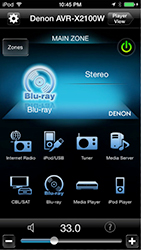
iPhone/iPod Touch version 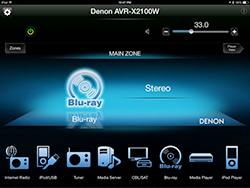
iPad version 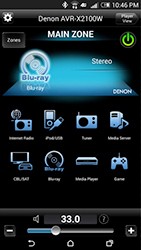
Android version
As you can see, they look pretty similar. This main page is well designed with good icons and a great layout. It is easy to quickly access whatever source device or service you wish to use, after which it indicates clearly what the current selection is. The power button is prominent and colored green for on and red for off, and since the receiver is listening on the network even when in standby mode, you can power the receiver on as well as off using the app. The volume can be manipulated either with the slider or the plus/minus buttons allowing for both easy incremental control as well as quick large changes in volume level.
The part about this app that I like the best, which is a great improvement over some other apps I have used, is that not only can you see the currently selected audio mode, but you can also tap on it and then get a full menu of available modes. You do have to cycle through a very small list of sub-modes for a given main mode, however. For example, I get the option to select “Dolby Surrounds”, which then cycles through the different Dolby modes. This is still much better than cycling through every single sub-mode. Just being able to see them on the device rather than have to watch on the screen is a welcome feature.
One thing I noted that the remote app does not seem to support is streaming media directly from the device on which it is running. I have seen this feature in other brands, and really like it. Certainly there are other ways to accomplish this, including the built-in Bluetooth functionality (at least for audio), but it would be much more user-friendly if there was an option to choose local media directly from within the app.
Other Network Features
Network control doesn’t stop with the remote app. Denon has ensured that a variety of control options are available. There is a web browser interface to allow full configuration of the unit from any standard web browser, making this a simple task from any laptop or PC running any OS. In addition, there is support for Control4’s SDDC protocol.
Obviously the other significant component of network integration is the ability to access network-based content. The X2100W has an extensive array of support for both internet and intranet based services. In addition to standard Internet Radio, the receiver supports Spotify, Pandora, and SiriusXM subscription services as well as Flickr. Internal to your home network, the receiver is fully DLNA (Digital Living Network Alliance) compliant, meaning it can access network shares from any DLNA compliant server on the network.
Windows servers/workstations are also supported. While some of these streaming audio options are interesting and potentially very useful for some, they don’t come close to the experience of a source component such as a Roku, Apple TV, or Xbox. The interfaces of said devices and the ease of use is simply orders of magnitude better than accessing this content directly on the receiver. This is pretty much the case with any receiver I have seen.
One intriguing feature that I was pretty excited to test out was the Apple Airplay support. The X2100W appears as an available Airplay target on any iOS device or in Mac OS X. However, every time I attempted to connect to the receiver from any of those devices (I tested an iPod Touch 5th Gen, and iPad Air, and a MacBook Pro running OS X Mavericks), it failed. I am not sure why this was the case, but I could not get it to work.
Finally, while not a sexy feature, being able to update the receiver firmware and software over the internet is a great option to have. I do mean both firmware and software here. Denon has included a facility for adding features to the receiver through downloads. Think Xbox Live or PlayStation Network but for A/V components. I think it is a great idea, though during my testing there was nothing available to download. I did manage to grab a couple of firmware updates, and I was very impressed with how quickly they download and apply as compared with older receivers when this sort of option first became available (to say nothing of updating via the old RS-232 port method!).
The Denon AVR-X2100W A/V Receiver In Use
the X2100W stood in for my everyday receiver perfectly, and performed marvelously. As I mentioned in the earlier part of this review, it features more than enough connectivity options to allow for all of the sources I use (and some I don’t but keep plugged in anyway). I normally do not keep on-screen display information active if I can avoid it as it usually distracts me, but in this case, the menus and graphics were nice enough looking and provided information I found useful so I kept it on. Source, audio mode, and video mode are all displayed quickly when the new source is selected, ensuring you can tell if you need to make any adjustments prior to a movie, for example. Another piece of interesting on-screen information is the Eco Mode status. Eco Mode is an amplifier feature that lowers power consumption in tune with lower volume, and there is a real-time display of how much power is being saved. It is much like the information you might get in a hybrid automobile that indicates how much electricity is being used vs gasoline at any given time.
Speaking of the amplifiers, as I have come to expect with Denon receivers, they performed superbly. The audio was crisp and clear at all sorts of volume levels. I was able to drive my 5.1 system louder than reference without any audible distortion, though I typically do not listen at those levels in my living room. I was also very pleased with low-volume performance. As my living room is directly below my upstairs bedrooms, it is imperative that I can enjoy good dynamic range even at low volumes, which was accomplished with the excellent Audyssey Dynamic EQ. In my configuration, I place the subwoofer in the back corner of my room, and with proper balance, it still blends in very well during low-volume listening. For those with multiple subwoofers, the unit does have 2 subwoofer outputs, so that’s an option as well. In addition, my living room flows into the kitchen in an open-concept layout, and the audio fills that area as well.
Conclusions about the Denon AVR-X2100W A/V Receiver
Overall, I have to say that the X2100W is an excellent choice for the price/performance you get. The feature set should satisfy anyone who is looking in this price range. As I have come to expect, the Denon quality continues with this unit. I am very impressed with the evolution of their user interface both on the receiver and on their mobile app. The audio codec support, 4K video support, and the ability to continue to receive software updates via the internet should also allow the unit to remain relevant and useful for many years, even as the industry throws more and more new features into the arena. I certainly consider this a unit I would purchase and use in my home theater, and thus, can confidently recommend it for yours.


